Charles E W Bean, Diaries, AWM38 3DRL 606/275/1 - 1918 - 1938 - Part 16
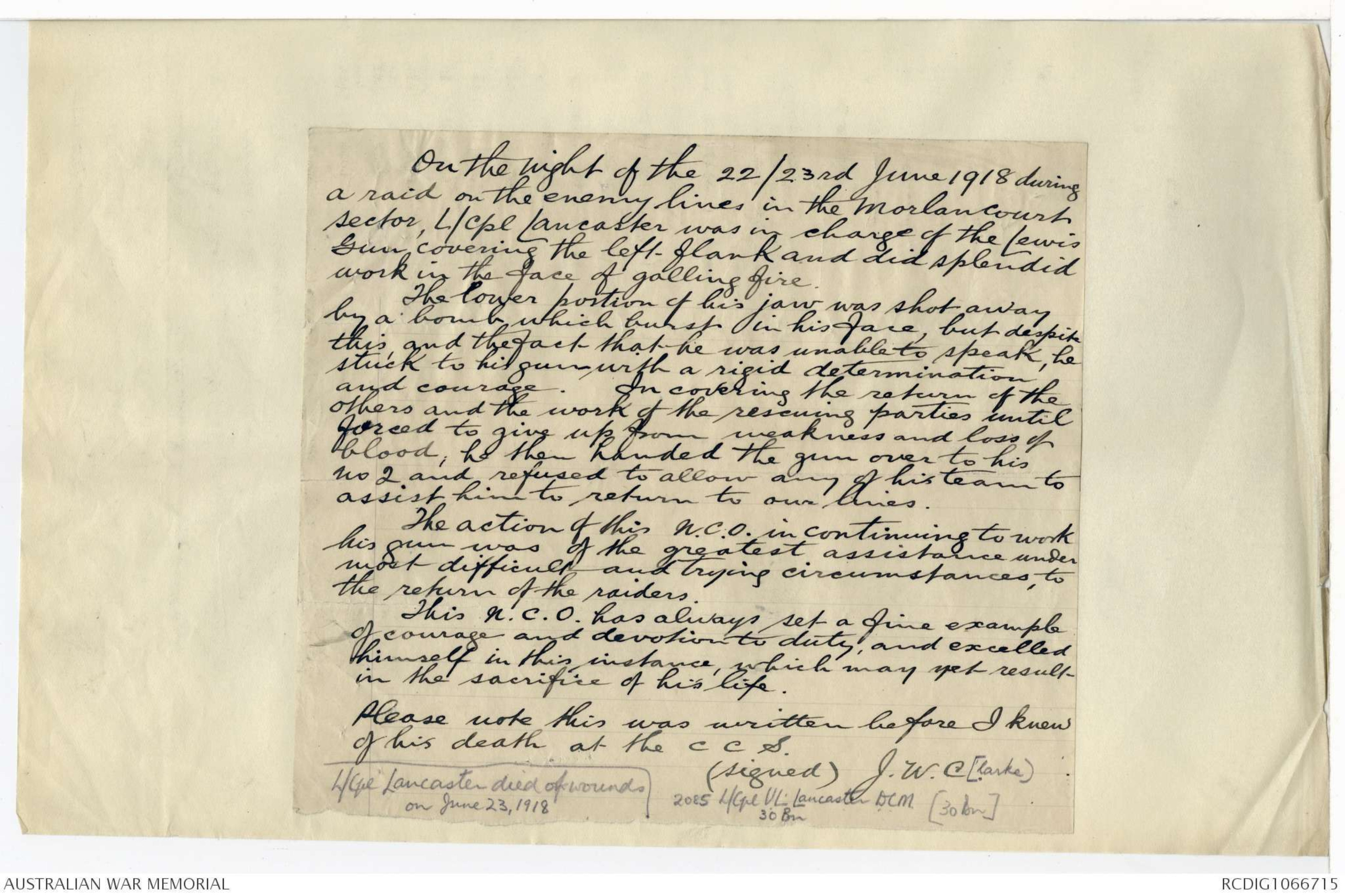
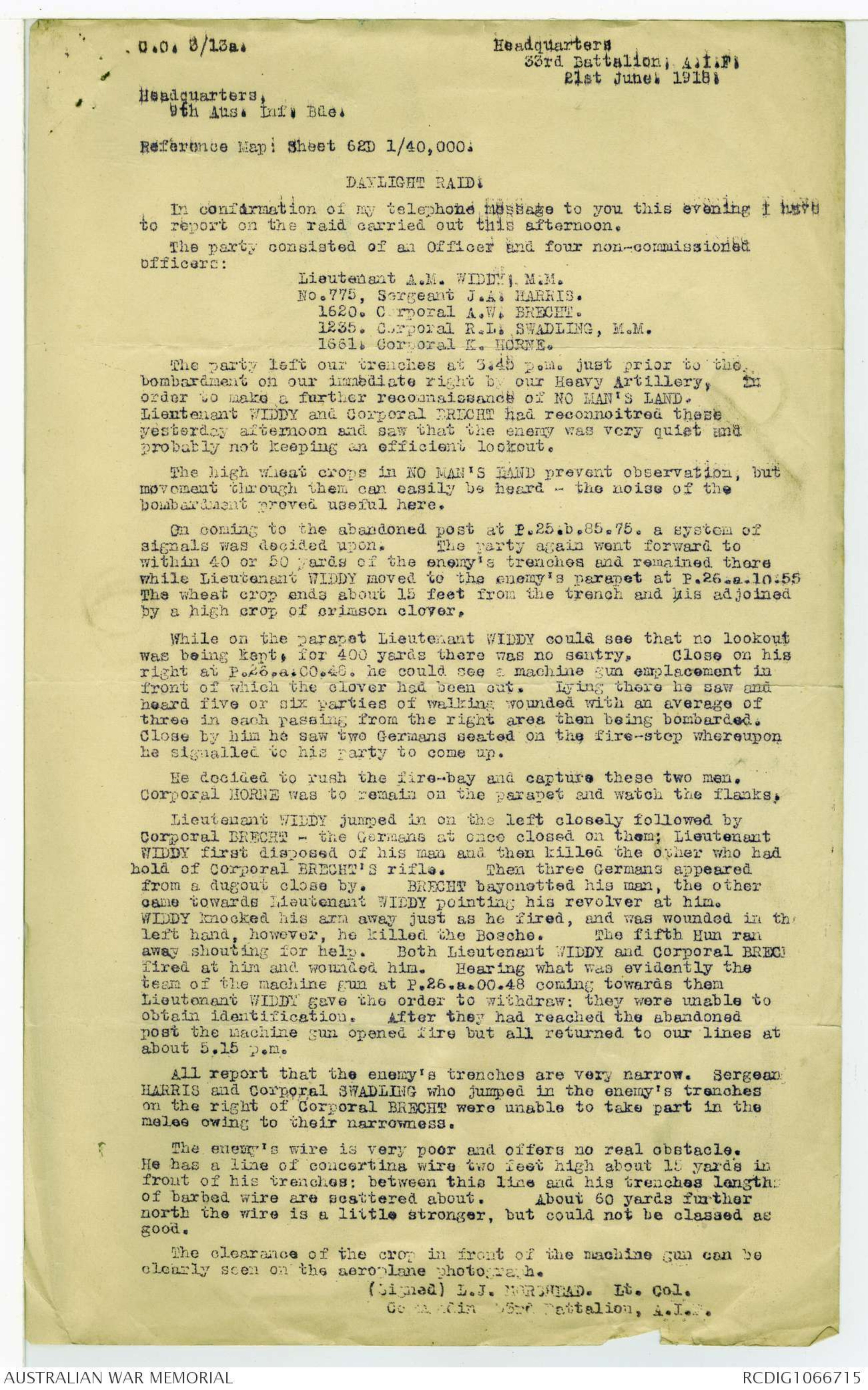
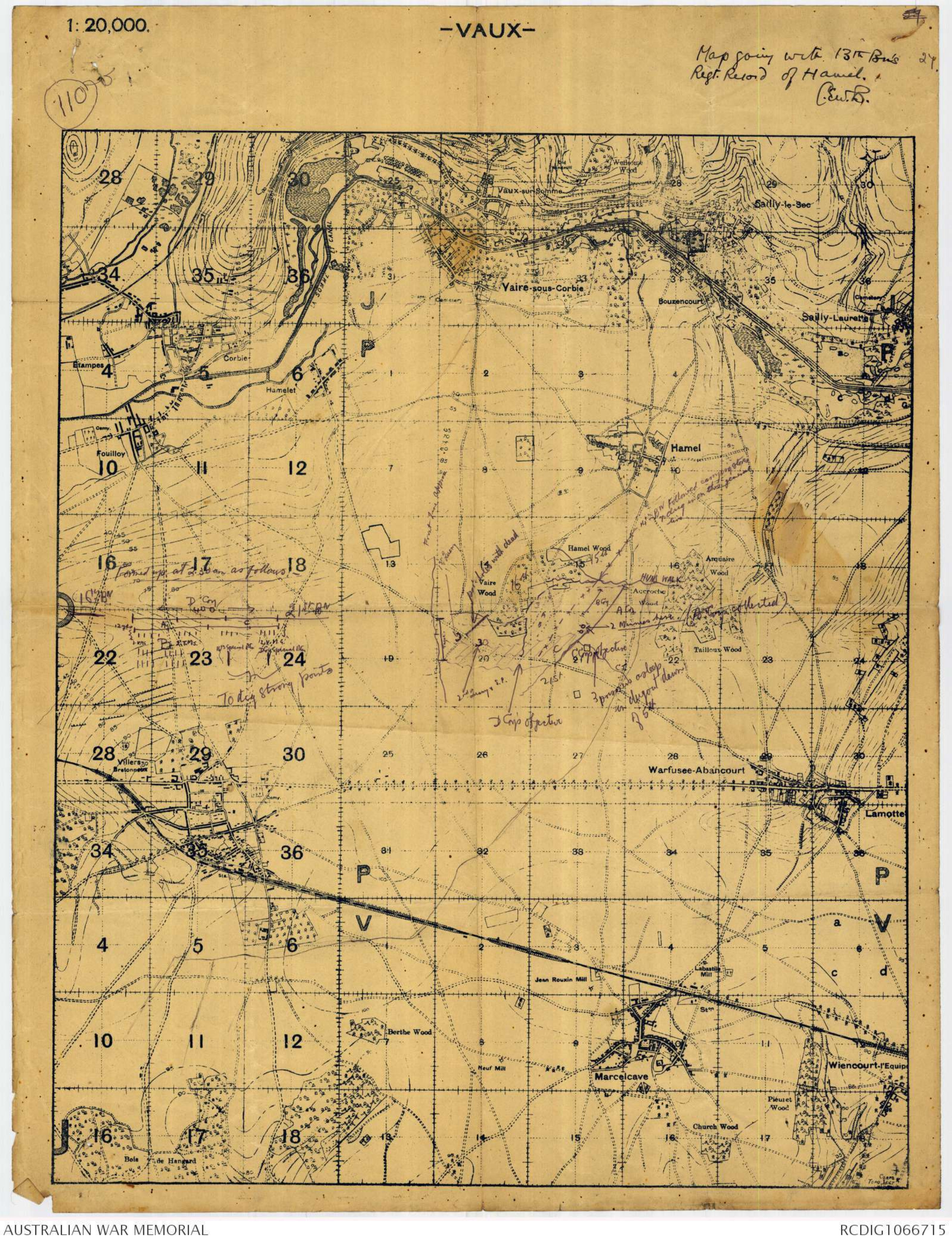
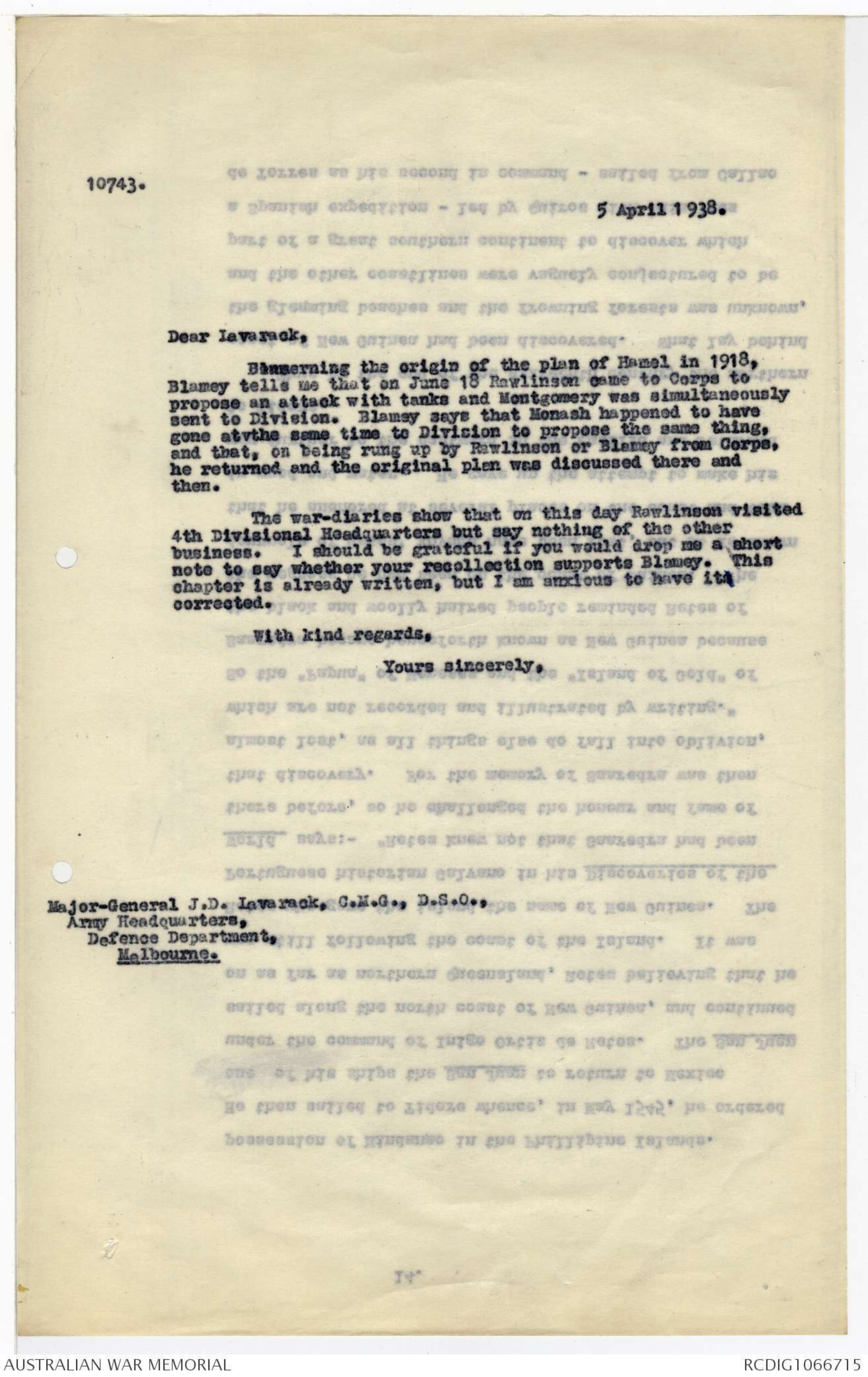
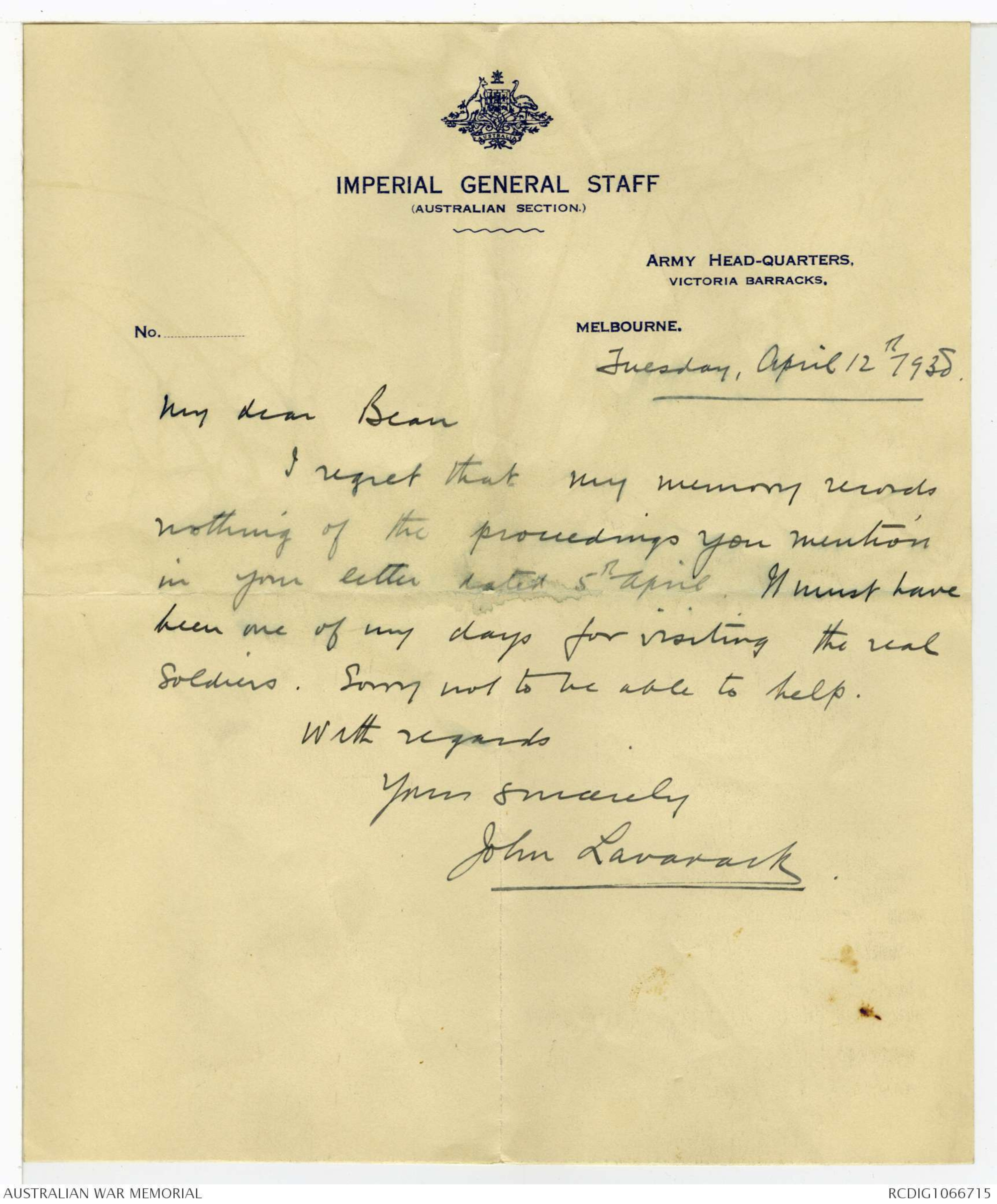

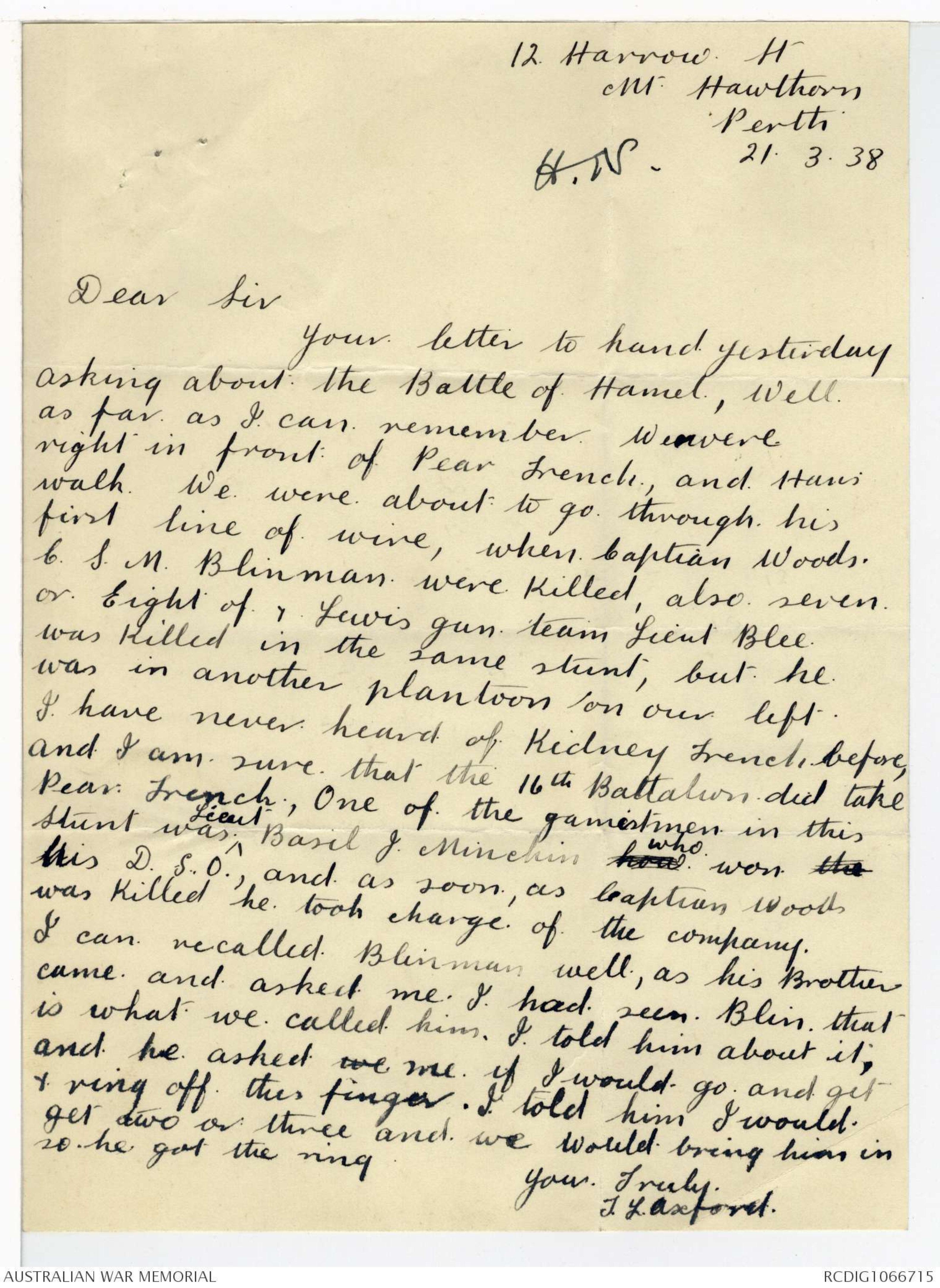
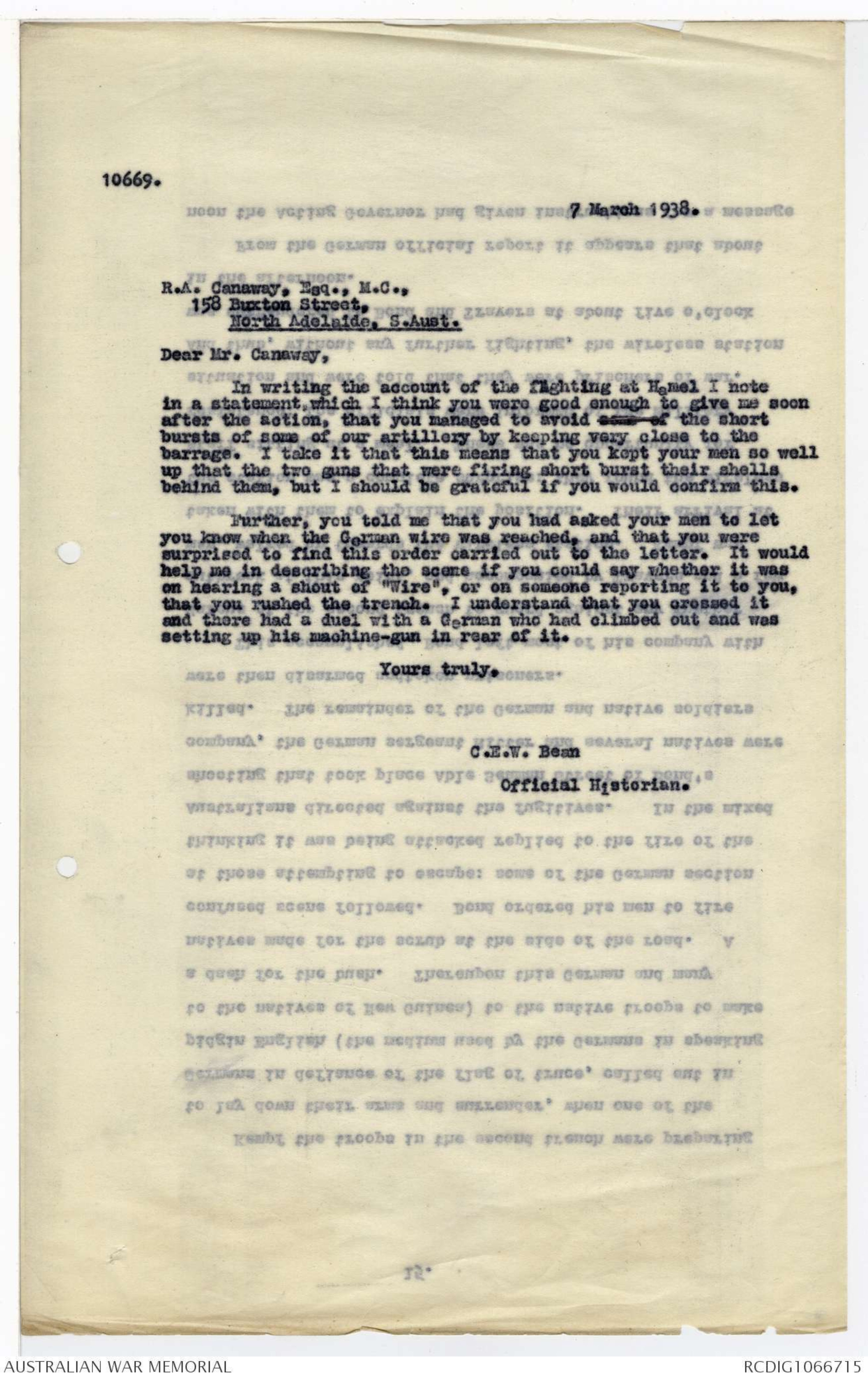
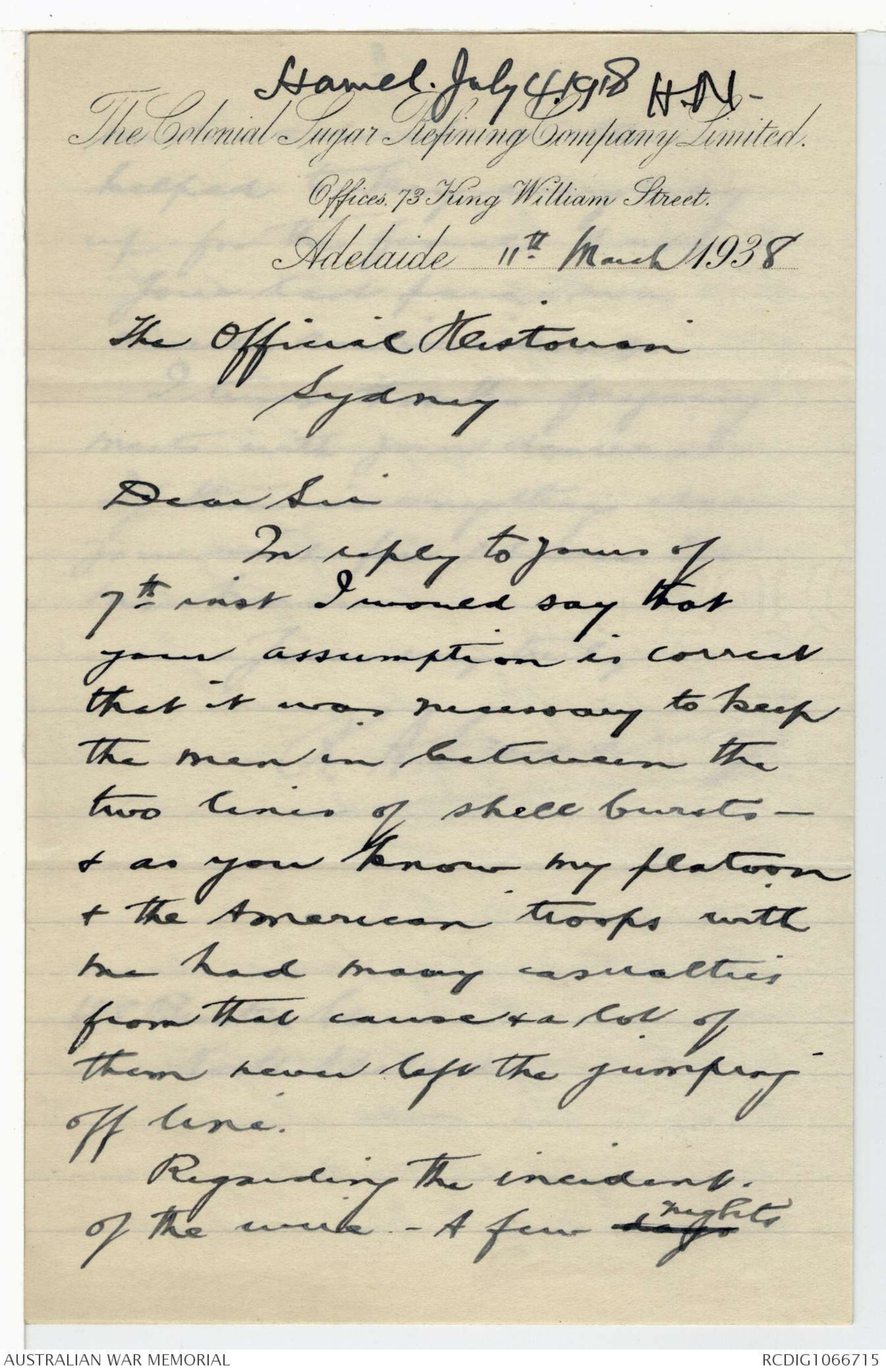
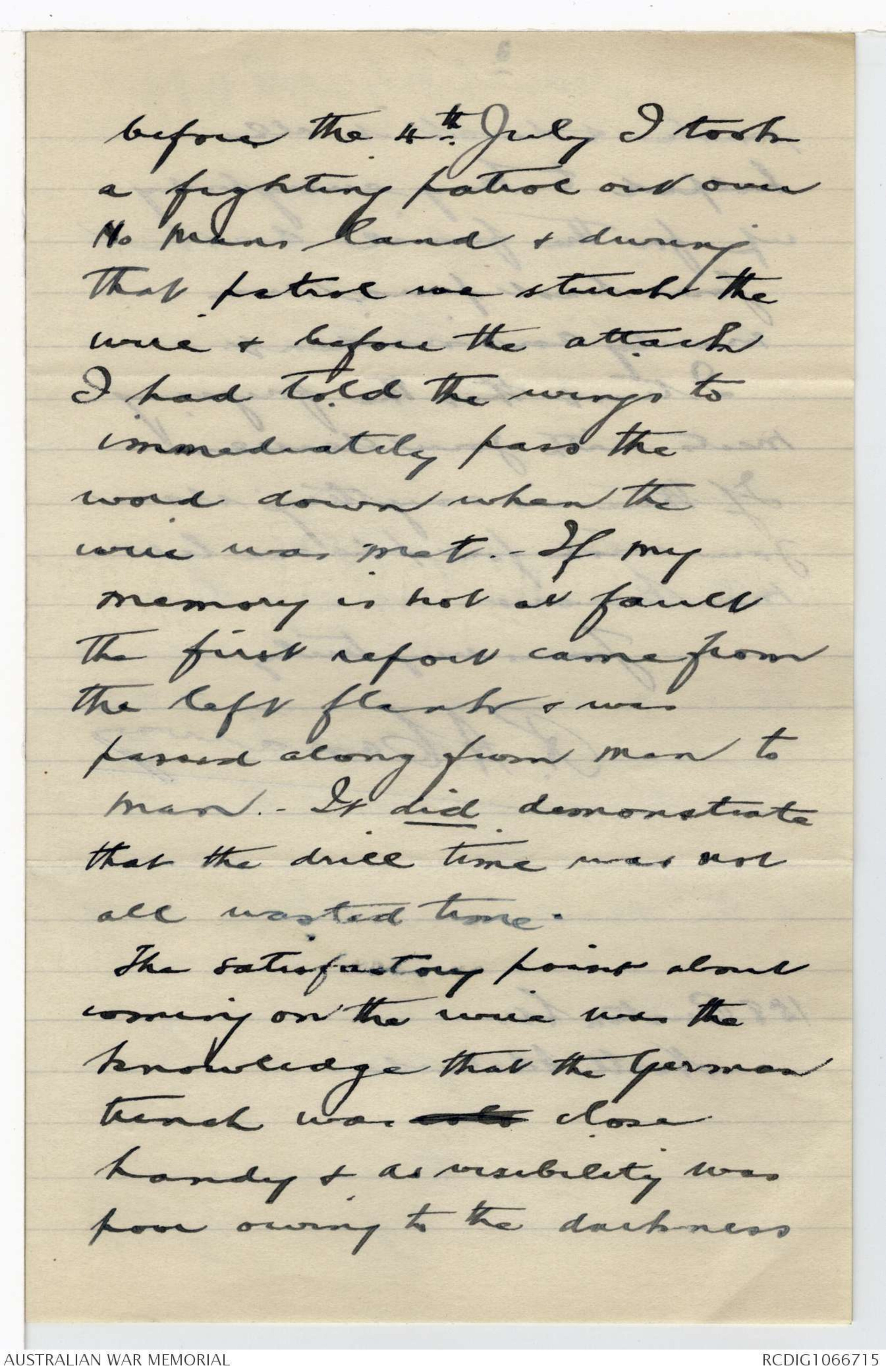
On the night of the 22/23rd June 1918 during
a raid on the enemy lines in the Morlancourt
sector, L/Cpl Lancaster was in charge of the Lewis
Gun covering the left flank and did splendid
work in the face of galling fire.
The lower position of his jaw was shot away
by a bomb which burst in his face, but despite
this, and the fact that he was unable to speak, he
stuck to his gun with a rigid determination
and courage. In covering the return of the
others and the work of the rescuing parties until
forced to give up from weakness and loss of
blood, he then handed the gun over to his
No 2 and refused to allow any of his team to
assist him to return to our lines.
The action of this N.C.O. in continuing to work
his gun was of the greatest assistance under
most difficult and trying circumstances, to
the return of the raiders.
This N.C.O. has always set a fine example
of courage and devotion to duty, and excelled
himself in this instance, which may yet result
in the sacrifice of his life.
Please note this was written before I knew
of his death at the CCS.
(signed) J.W. C[larke)
[*L/Cpl Lancaster died of wounds
on June 23, 1918*]
[*2085 L/Cpl VL.Lancaster D.C.M. [30Bn]
30Bn*]
G.O. 3/13a.
Headquarters
33rd Battalion A.I.F.
21st June. 1918.
Headquarters,
9th Aus. Inf. Bde.
Reference Map: Sheet 62D 1/40,000.
DAYLIGHT RAID.
In confirmation of my telephone message to you this evening I have
to report on the raid carried out this afternoon.
The party consisted of an Officer and four non-commissioned
officers:
Lieutenant A.M. WIDDY, M.M.
No.775, Sergeant J.A. HARRIS.
1620. Corporal A.W. BRECHT.
1235. Corporal R.L. SWADLING, M.M.
1661. Corporal K. HORNE.
The party left our trenches at 3.45 p.m. just prior to the
bombardment on our immediate right by our Heavy Artillery, in
order to make a further reconnaissance of NO MAN'S LAND.
Lieutenant WIDDY and Corporal BRECHT had reconnoitred these
yesterday afternoon and saw that the enemy was very quiet and
probably not keeping an efficient lookout.
The high wheat crops in NO MAN'S LAND prevent observation, but
movement through them can easily be heard - the noise of the
bombardment proved useful here.
On coming to the abandoned post at P.25.b.85.75. a system of
signals was decided upon. The party again went forward to
within 40 or 50 yards of the enemy’s trenches and remained there
while Lieutenant WIDDY moved to the enemy's parapet at P.26.a.10.55
The wheat crop ends about 15 feet from the trench and his adjoined
by a high crop of crimson clover.
While on the parapet Lieutenant WIDDY could see that no lookout
was being kept, for 400 yards there was no sentry. Close on his
right at P.26.a.CO.46. he could see a machine gun emplacement in
front of which the clover had been cut. Lying there he saw and
heard five or six parties of walking wounded with an average of
three in each passing from the right area then being bombarded.
Close by him he saw two Germans seated on the fire-stop whereupon
he signalled to his party to come up.
He decided to rush the fire-bay and capture these two men.
Corporal HORNE was to remain on the parapet and watch the flanks.
Lieutenant WIDDY jumped in on the left closely followed by
Corporal BRECHT - the Germans at once closed on them; Lieutenant
WIDDY first disposed of his man and then killed the other who had
hold of Corporal BRECHT'S rifle. Then three Germans appeared
from a dugout close by. BRECHT bayonetted his man, the other
came towards Lieutenant WIDDY pointing his revolver at him.
WIDDY knocked his arm away just as he fired, and was wounded in the
left hand, however, he killed the Bosche. The fith Hun ran
away shouting for help. Both Lieutenant WIDDY and Corporal BRECHT
fired at him and wounded him. Hearing what was evidently the
team of the machine fun at P.26.a.00.48 coming towards them
Lieutenant WIDDY gave the order to withdraw: they were unable to
obtain identification. After they had reached the abandoned
post the machine gun opened fire but all returned to our lines at
about 5.15 p.m.
All report that the enemy's trenches are very narrow. Sergeant
HARRIS and Corporal SWADLING who jumped in the enemy's trenches
on the right of Corporal BRECHT were unable to take part in the
melee owing to their narrowness.
The enemy's wire is very poor and offers no real obstacle.
He has a line of concertina wire two feet high about 15 yards in
front of his trenches: between this line and his trenches lengths
of barbed wire are scattered about. About 60 yards further
north the wire is a little stronger, but could not be classed as
good.
The clearance of the crop in front of the machine gun can be
clearly seen on the aeroplane photograph.
(Signed) L.J. MORSHEAD . Lt. Col.
Commanding 33rd Battalion A.I.F.
Map going with 13th Bn's 27
Regt. Record of Hamel
C.E.W.B.
110
Map - see original document
10743.
5 April 1938.
Dear Lavarack,
Concerning the origin of the plan of Hamel in 1918,
Blamey tells me that on June 18 Rawlinson came to Corps to
propose an attack with tanks and Montgomery was simultaneously
sent to Division. Blamey says that Monash happened to have
gone atvthe same time to Division to propose the same thing,
and that, on being rung up by Rawlinson or Blamey from Corps,
he returned and the original plan was discussed there and
then.
The war-diaries show that on this day Rawlinson visited
4th Divisional Headquarters but say nothing of the other
business. I should be grateful if you would drop me a short
note to say whether your recollection supports Blamey. This
chapter is already written, but I am anxious to have its
corrected.
With kind regards,
Yours sincerely,
Major-General J.D. Lavarack, C.M.G., D.S.O.,
Army Headquarters
Defence Department,
Melbourne.
IMPERIAL GENERAL STAFF
(AUSTRALIAN SECTION)
ARMY HEAD-QUARTERS.
VICTORIA BARRACKS,
MELBOURNE.
No......
Tuesday, April 12th 1938.
My dear Bean
I regret that my memory records
nothing of the proceedings you mention
in your letter dated 5th April. It must have
been one of my days for visiting the real
soldiers. Sorry not to be able to help.
With regards
Yours sincerely
John Lavarack.
10674.
8 March 1938.
T.L. Axford, Esq., V.C., M.M.,
57, Mabel Street,
North Perth. W.Aust.
Dear Sir,
In writing the account of the Battle of Hamel for
the Official History I find that your name and the action for
which you won your decoration were associated in the reports
with Pear Trench. According to records here, however, Pear
Trench was far inside the boundary of the 15th Battalion and
about 500 yards from the left flank of the 16th. There was
another trench similar in shape, just on the top of the slope
near Vaire Wood, which was sometimes called "Kidney Trench",
and this lay in front of the 16th Battalion's left company.
I am wondering whether this was not the trench referred to.
I should be grateful for anything that you can tell
me relating to the incident, in particular whether this was
where Captain Woods, Lieutenant Blee, and C.S.M. Blinman were
killed.
Yours truly,
C.E.W. Bean
Official Historian.
12. Harrow. St
Mt. Hawthorn
Perth
21. 3. 38
H.N.
Dear Sir
Your letter to hand yesterday
asking about the Battle of Hamel, Well.
as far as I can remember. We were
right in front of Pear French, and Huns
walk. We were about to go. through his
first line of wire, when Captain Woods.
C. S. M. Blinman were Killed, also seven.
or. eight of & Lewis gun. team Lieut Blee
was killed in the same stunt, but he
was in another plantoon on our left.
I have never heard of Kidney Trench before,
and I am sure. that the 16th Battalion did take
Pear French, One of the gamistmen in this
stunt was, ^Lieut Basil J. Minchin how who won the
his D.S.O., and as soon, as Captain Woods
was Killed he took charge of the company.
I can recalled Blinman well, as his Brother
came and asked me. I had seen. Blin. that
is what we called him. I told him about it,
and he asked we me if I would go and get
a ring off this finger. I told him I would
get two or three and we would bring him in
so he got the ring
Your. Truly.
T. L. Axford.
10669.
7 March 1938.
R.A. Canaway, Esq., M.C.,
158 Buxton Street,
North Adelaide, S.Aust.
Dear Mr. Canaway,
In writing the account of the fighting at Hamel I note
in a statement, which I think you were good enough to give me soon
after the action, that you managed to avoid some of the short
bursts of some of our artillery by keeping very close to the
barrage. I take it that this means that you kept your men so well
up that the two guns that were firing short burst their shells
behind them, but I should be grateful if you would confirm this.
Further, you told me that you had asked your men to let
you know when the German wire was reached, and that you were
surprised to find this order carried out to the letter. It would
help me in describing the scene if you could say whether it was
on hearing a shout of "Wire", or on someone reporting it to you,
that you rushed the trench. I understand that you crossed it
and there had a duel with a German who had climbed out and was
setting up his machine-gun in rear of it.
Yours truly.
C.E.W. Bean
Official Historian.
Hamel. July 4, 1918 H.N.
The Colonial Sugar Refining Company Limited.
Offices 73 King William Street.
Adelaide 11th March 1938
The Official Historian
Sydney
Dear Sir
In reply to yours of
7th inst I would say that
your assumption is correct
that it was necessary to keep
the men in between the
two lines of shell bursts -
& as you know my platoon
& the American troops with
me had many casualties
from that cause & a lot of
them never left the jumping
off line.
Regarding the incident,
of the wire. - A few days nights
before the 4th July I took
a fighting patrol out over
No Mans land & during
that patrol we stuck the
wire & before the attack
I had told the wings to
immediately pass the
word down when the
wire was met. If my
memory is not at fault
the first report came from
the left flank & was
passed along from man to
man. It did demonstrate
that the drill time was not
all wasted time.
The satisfactory point about
coming on the wire was the
knowledge that the German
trench was cols close
handy & as visibility was
poor owing to the darkness
 Sam scott
Sam scottThis transcription item is now locked to you for editing. To release the lock either Save your changes or Cancel.
This lock will be automatically released after 60 minutes of inactivity.